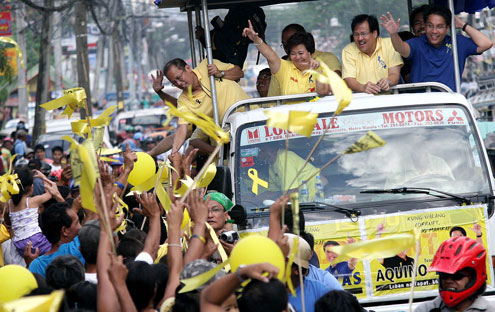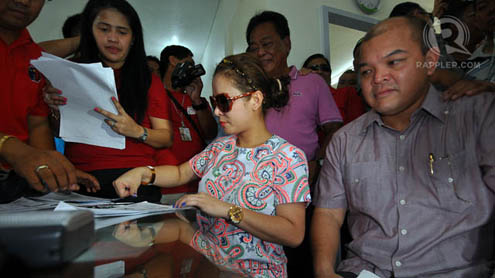Is Aquino Moving the Philippines Closer to Good Governance?
Philippine President Benigno Aquino secured big wins in the May midterm elections, which were seen as vital to his ambitious reform agenda. Aquino now marks the midpoint of his single six-year term as president, and while it might be clear that politics has yet to change in the last three years, it’s less clear the extent to which changes in governance may point to longer-term political changes.

Philippine President Benigno Aquino marks the midway point in his term since he was elected in 2010. Midterm elections this month were seen as a test to his ambitious reform agenda. Photo/Flickr user thepocnews
As early as the 2010 presidential campaign, then presidential candidate Benigno Aquino III together with his vice-presidential running mate, Mar Roxas, had governance reforms in mind when they said that it would take two presidential terms (of six years each) to transform the country from a regime of bad to good governance, to demonstrate that “Kung Walang Kurupt, Walang Mahirap” (“if there is no corruption, there will be no poverty”). The notion was that corruption was so ingrained in the system that six years would be needed just to initiate the key strategic reforms and another six years needed to institutionalize them.
Many discussions of reform list as examples the well-publicized change in the ombudsman, the arrest of former President Arroyo, and the impeachment conviction of the Chief Justice of the Supreme Court. While these efforts required considerable political capital, Aquino was inevitably subject to criticism of the sincerity and wisdom of his good governance campaign. As Peter Koeppinger, Resident Representative of the Konrad Adenauer Foundation in the Philippines, aptly put it: “Corruption is everywhere. In many public agencies, it is organized in networks, making it difficult to break up. The government needs a much more comprehensive strategy to reduce the endemic corruption.”
One of the most significant strategic reforms to which the government itself has committed so far is the Philippine Government Action Plan, entitled “Institutionalizing People Power in Governance to Ensure Direct, Immediate, and Substantial Benefits for the Poor.” The plan is anchored upon transparent, accountable, and participatory governance as a key ingredient to achieving poverty reduction and economic expansion. In this plan, the government is committed to undertake 19 initiatives: two in transparency (including disclosing budget information of all major departments and a roadmap for improving public access to information); five in citizen participation (including expanding participatory budgeting and bottom-up budgeting, establishing an empowerment fund and undertaking participatory audits); four in accountability (including the Results-Based Performance Management System); and eight in technology and innovation. Thus, the Action Plan combines both greater involvement of the citizenry in governance affairs with internal changes in how the bureaucracy operates.
Watchdog functions are not new in the Philippines. Myriad coalitions have organized to monitor the delivery of various government services and public processes. However, the collaborative implementation of the bottom-up-budgeting (BUB) between municipal governments and citizen groups, abetted by a system of national government incentives and disincentives, has the makings of real radical reform. The BUB, first introduced in the 2012 budget process and now on its second budget cycle, is the government’s new approach to the preparation of the national budget to reduce poverty and achieve the country’s MDG targets. It begins with proposals from a participatory planning process between local government officials and constituent citizen’s groups as a starting point for national government agency budgeting to achieve what the government calls “a people-centric budget.” It seeks to ensure that critical and priority local development projects are increasingly funded by the national budget and less dependent on arbitrary and capricious pork barrel spending. The approach strengthens responsiveness of national and local government programs and processes while encouraging a “me-too mentality” among local leaders for a more transparent and participatory governance. It can be argued that providing incentives for the national government, local governments, and the citizenry, as they all benefit from this new process, makes it more difficult to roll back this reform.
The rearrangement of incentives seems to be the implicit formula for other key reforms. The Performance Challenge Fund and Seal of Good Housekeeping for local governments are complementary programs that set up transparency and accountability standards for LGU and provide incentives for local governments that achieve them. These typify the governance-through-CSO-engagement approach that the current administration has undertaken in a major way. Indeed, it will go even further with the soon-to-be-released Empowerment Fund, a well-resourced private and public fund allotted to projects that strengthen CSO capacity to participate in these reforms and, in turn, build communities’ capacity to demand the continuity of reforms. The fund will be composed of counterpart contributions from both government funds and funds from local financing institutions (LFIs). The fund is seen as critical for the institutionalization of CSO engagement in governance reform. This of course would follow the logic that CSO engagement is critical to the success of citizen involvement in transforming our public institutions.
When it comes to the internal bureaucratic reform, the Department of Budget and Management is effectively the process-keeper of important institution-building elements of the program. These include fiscal discipline (e.g., doing away with undue budget discretion and lump sum funds and enforcing transparency and accountability among “sacred cows” including the military, national security, and the judiciary), as well as allocative and operational efficiency via the Organizational Performance Indicator Framework (OPIF), zero-based budgeting (ZBB), and the Results-Based Performance Management System (RBPMS), three examples of complementary results-based approaches to strengthen and rationalize the government’s public expenditure management.
The administration thus has a strong emphasis on both the supply side (bureaucratic reform) and the demand side (citizen involvement) of the reform equation.
So, is governance in fact changing for the better? While reformers in key leadership positions who know how to use both the technical and political leverage provided by these positions, represent a significant factor that cannot be overstated, the challenge of winning over the middle-level bureaucrats is where the battle will ultimately be won. Needless to say, the challenge of institutionalizing these programs and initiatives remains.
Conscious of the tenuousness of the reform situation, Department of Budget and Management Secretary Florencio Abad has identified the task of resisting policy reversal as one half of the core agenda for the next three years (the other being achieving inclusive growth). In the end, institutionalized change remains inextricably linked to Aquino’s successor, and therefore very much in the hands of the electorate.
Jose Maria M. Mendoza is program leader for the Coalitions for Change Program, an activity under the AusAID-Asia Foundation Partnership in the Philippines, and Steven Rood is The Asia Foundation’s country representative there. They can be reached at [email protected] and [email protected], respectively. The views and opinions expressed here are those of the individual authors and not those of The Asia Foundation.

